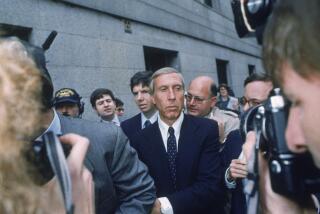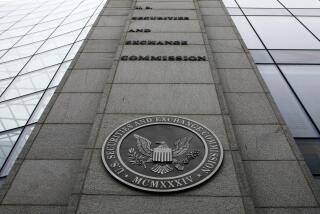Report Lauds SEC but Sees Need to Do More to Fight Insider Trading
- Share via
WASHINGTON — The Securities and Exchange Commission is gradually improving its surveillance systems “for detecting and analyzing suspicious trades” that may be based on the illegal use of inside information, congressional auditors have concluded.
But in a report to be presented to Congress this morning, auditors for the General Accounting Office say the SEC must do more to “develop a link between that (stock) activity and the suspected guilty parties.”
The GAO’s report, a copy of which was obtained by The Times, is scheduled to be given to the House Energy and Commerce oversight and investigations subcommittee as it opens hearings into the Wall Street scandal revolving around the Ivan F. Boesky insider trading case.
While commending the SEC and the securities industry for their computerized methods of detecting unusual trading activity, the GAO study concludes that much more needs to be done. It notes that “proving culpability remains difficult and laborious” for the SEC unless, as in the Boesky case, the agency obtains cooperation from a participant in the activity.
“Surveillance system disclosures are not sufficient by themselves to enable the SEC and the Justice Department to prove illegal (insider trading) activity,” the report says. “They merely provide leads that may be pursued by analysis and investigation.”
While electronic monitoring systems are improving, “they do not yet provide for all the automated analyses the SEC believes are necessary to successfully identify various types of potential trading abuses,” according to the report.
The hearings will be chaired by Rep. John D. Dingell (D-Mich.). After today’s session, which will include testimony from SEC Chairman John S. R. Shad and Gary Lynch, the agency’s enforcement chief, the hearings will recess until members of the new Congress are sworn in next year.
When individuals illegally buy or sell securities based on inside information--non-public details of a corporation’s plans or performance--they may trade so aggressively in the pursuit of substantial profits that regulators often detect abnormal trading patterns, the report notes.
“Someone who normally does not trade may start doing so based on insider information, or someone might trade an unusually large amount of shares in advance of a corporate announcement,” the study said.
Other Means of Detection
But computer systems alone are not the sole means of detecting insider trading, it added, because “other parties such as specialists, floor governors and even brokerage houses often bring unusual situations to the attention” of stock exchanges or government regulators.
Effective monitoring of stock activity “is an enormous task,” the GAO said, because more than 75,000 trades involving 150 million shares occur on an average day at the New York Stock Exchange alone. In addition, thousands of trades occur daily in other markets.
Moreover, “even the most sophisticated computer surveillance systems will not produce the evidence necessary to link questionable trades with one or more individuals using inside information,” the report said.
Such systems can show, after the fact, “who traded what stock at what prices and when--but they do not produce irrefutable evidence showing who passed inside information to whom,” the study said.
Inquiry Broadening
Meanwhile, the federal probe in which Boesky is cooperating was reported to be broadening Wednesday to include scrutiny of stock speculators known as arbitrageurs and their effect on the market, even when they do not possess inside information.
Sources familiar with the case said SEC attorneys, as well as congressional staff members, are considering whether federal laws are violated if speculators act together to purchase large blocks of stocks, or encourage such purchases, without publicly disclosing their actions.
SEC rules require that once an investor acquires more than 5% of a company’s shares, he must publicly disclose that fact to the corporation. But the rules seldom have been enforced against two or more loosely connected investors whose purchases together total more than 5%, attorneys said.
More to Read
Inside the business of entertainment
The Wide Shot brings you news, analysis and insights on everything from streaming wars to production — and what it all means for the future.
You may occasionally receive promotional content from the Los Angeles Times.










